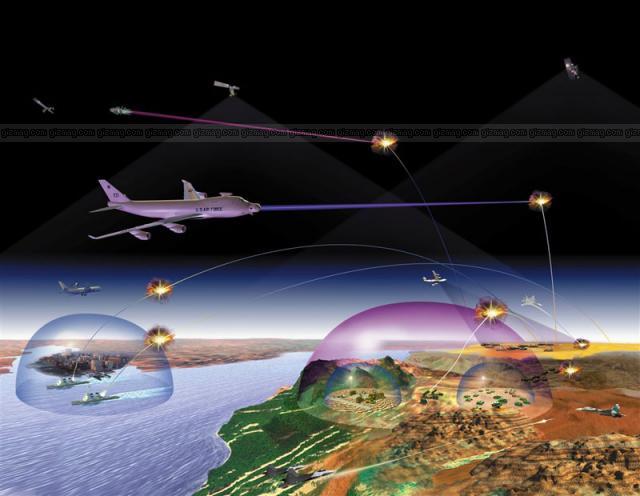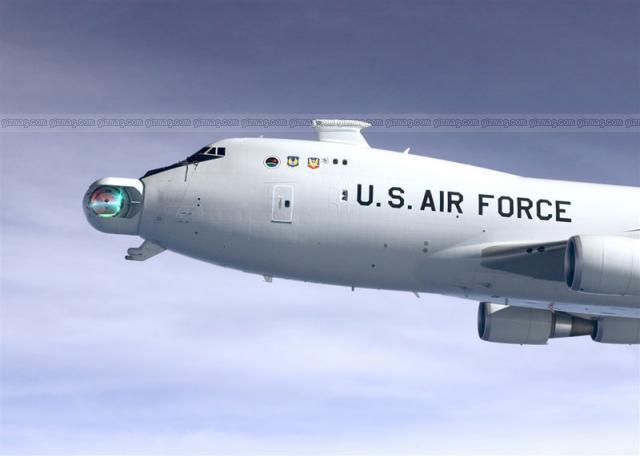

Airborne Laser demonstrates optical beam train
June 27, 2006 The United States’ Airborne Laser (ABL) program sounds so fantastic that it’s hard to believe that it’s on track to be operational within two years. ABL will feature the world's first megawatt-class laser weapon system integrated on a specially configured aircraft to autonomously detect, track and destroy all classes of hostile ballistic missiles at the speed-of-light. The ABL team and the U.S. Missile Defense Agency (MDA) took a major step toward demonstrating the capability of ABL this week by successfully firing surrogate lasers from inside the aircraft. The high-energy laser, which achieved lethal power and run-times in a ground laboratory, will be installed in the ABL aircraft in 2007 to prepare for the program's first missile shoot-down test, slated for 2008.
During recent ground tests, the team placed the lasers in the ABL aircraft, a modified Boeing 747-400F, and fired them repeatedly into a measuring device called a range simulator. The tests verified that the ABL team properly aligned the optical beam train, a series of optical components, steering and deformable mirrors, and sensors that will guide lasers to an actual target. The equipment exercised in the tests is part of the beam control/fire control system designed and integrated by Lockheed Martin.
The lasers used in the tests were low-power surrogates for ABL's high-energy laser and two illuminator lasers. The program plans to install actual illuminators in the jet for ground and flight tests later this year. The track illuminator laser is designed to track all classes of hostile ballistic missiles. The beacon illuminator laser will measure atmospheric conditions, allowing the beam control/fire control system to compensate for atmospheric turbulence in the high-energy laser's path to a target. During this year's flight tests, the illuminators will be fired in flight at a missile-shaped image painted on a test aircraft.
"The surrogate-laser tests provide further proof that the ABL design is sound," said Pat Shanahan, vice president and general manager of Boeing Missile Defense Systems. "They also bring ABL closer to important flight testing later this year and to the 2008 lethal shoot-down milestone. This is an exciting time for the program, and our team has worked hard to make it that way."
Boeing provides the modified aircraft and the battle management system and is the overall systems integrator.
ABL partners include the prime contractor, Boeing, Northrop Grumman, which supplies the high-energy laser and the beacon illuminator laser, and Lockheed Martin, which provides the nose-mounted turret in addition to the beam control/fire control system.
June 27, 2006 The United States’ Airborne Laser (ABL) program sounds so fantastic that it’s hard to believe that it’s on track to be operational within two years. ABL will feature the world's first megawatt-class laser weapon system integrated on a specially configured aircraft to autonomously detect, track and destroy all classes of hostile ballistic missiles at the speed-of-light. The ABL team and the U.S. Missile Defense Agency (MDA) took a major step toward demonstrating the capability of ABL this week by successfully firing surrogate lasers from inside the aircraft. The high-energy laser, which achieved lethal power and run-times in a ground laboratory, will be installed in the ABL aircraft in 2007 to prepare for the program's first missile shoot-down test, slated for 2008.
During recent ground tests, the team placed the lasers in the ABL aircraft, a modified Boeing 747-400F, and fired them repeatedly into a measuring device called a range simulator. The tests verified that the ABL team properly aligned the optical beam train, a series of optical components, steering and deformable mirrors, and sensors that will guide lasers to an actual target. The equipment exercised in the tests is part of the beam control/fire control system designed and integrated by Lockheed Martin.
The lasers used in the tests were low-power surrogates for ABL's high-energy laser and two illuminator lasers. The program plans to install actual illuminators in the jet for ground and flight tests later this year. The track illuminator laser is designed to track all classes of hostile ballistic missiles. The beacon illuminator laser will measure atmospheric conditions, allowing the beam control/fire control system to compensate for atmospheric turbulence in the high-energy laser's path to a target. During this year's flight tests, the illuminators will be fired in flight at a missile-shaped image painted on a test aircraft.
"The surrogate-laser tests provide further proof that the ABL design is sound," said Pat Shanahan, vice president and general manager of Boeing Missile Defense Systems. "They also bring ABL closer to important flight testing later this year and to the 2008 lethal shoot-down milestone. This is an exciting time for the program, and our team has worked hard to make it that way."
Boeing provides the modified aircraft and the battle management system and is the overall systems integrator.
ABL partners include the prime contractor, Boeing, Northrop Grumman, which supplies the high-energy laser and the beacon illuminator laser, and Lockheed Martin, which provides the nose-mounted turret in addition to the beam control/fire control system.

Comment